After suffering for so long from drought, the flooding rains finally came. Having prepped the dams, storage capacity was in place but an unfortunate blow out required Ron Horner to undertake urgent repair works with his trusty Cat 311 excavator
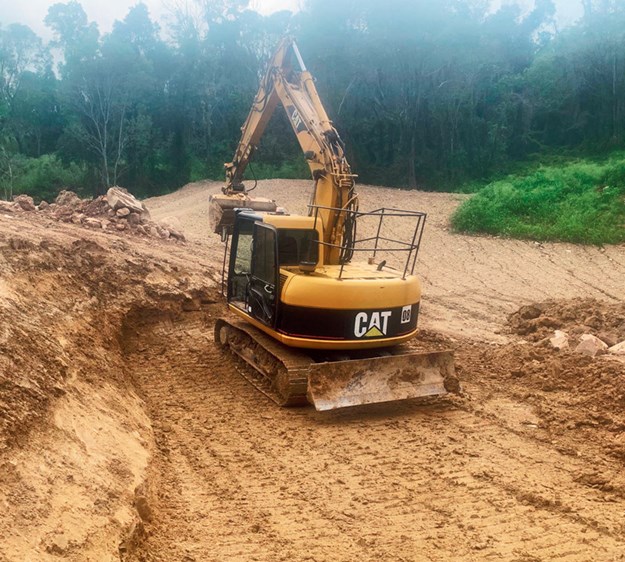 |
|
Rectification works undertaken with Cat 311cu excavator
|
Australia has just endured one of the worst drought periods in living memory.
This past 18-month period of well below average rainfall and extremely hot conditions has certainly made most of us aware of the importance of saving the precious liquid that most of us take for granted.
City dwellers are used to turning on the tap and in an instant having as much clean hot or cold water as they want, but for those in the bush (who are just extremely grateful to have just enough water for the basics), life has been more than difficult for everyone.
Rural folk are totally dependent upon the heavens opening and some divine intervention to make life easier, to enable stock to feed and drink and to enable cropping to proceed without bank managers intervening with threats of mortgage closure because Mother Nature has, albeit temporarily, called “time out”.
Earthmoving contractors have enjoyed a long period of continued work in either cleaning out dams or creating new ones (for those landowners whom could still afford to do so). Millions of dollars have been invested in both large and small land holdings to stave off the future effects of extended dry periods. Some projects have been hugely successful and others have been doomed to failure for a myriad of reasons.
Such was the case when I was engaged to sort out a problem on a newly constructed dam built in a steep and rocky location.
This dam was built more than a year ago during the driest period the district had seen in over 80 years. They weren’t the best conditions to be constructing a new dam in as the materials selected had not seen any moisture for about a year and even at a depth of five metres were still quite dry – risky to say the least but worthwhile, taking into consideration the extenuating drought conditions.
 |
|
Dam wall blowout, caused by expansion of the clay
|
THE WET
Every drought has ended with a flood. When the heavens eventually opened up the client waited with baited breath for those expensive holes in the ground to eventually fill to the brim and ease his mind and bank balance. The excitement was short lived however, as he watched his precious water run through the cracks of the walls of his dams and over the edge of the mountain, leaving him with a bigger problem than he had before the big wet hit.
This is not unusual in many dam construction projects undertaken in extremely dry conditions where on-site water is just not available to assist in conditioning the clay used to build the dam. Long periods of extreme heat cause the material to expand, leaving cracks in the walls and base.
It is only when the rains come that one can assess whether the construction has been successful –however, the longer they stay dry the more likely the dams will develop cracks.
After the rains had eased enough to make a detailed inspection of the dam walls it was found that, although the dam wall base was about 40m wide, water had found its way through some developing cracks and punched a hole some 1.5m in diameter through the bottom of the wall some 1.2 metres above the existing water level.
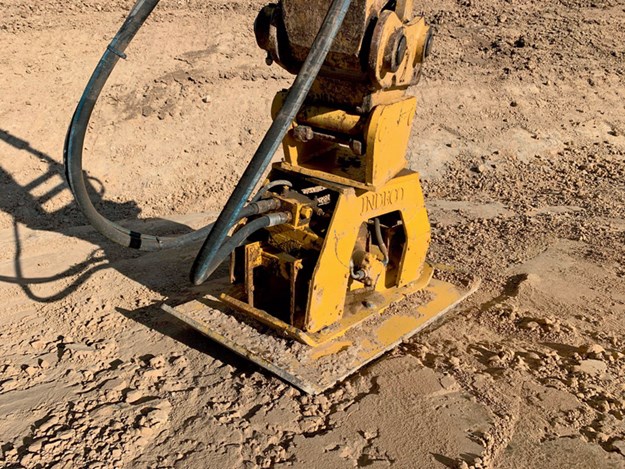 |
|
The key to a successful outcome – the Indeco compaction plate – not only minimises risk when compacting in deep excavations but achieves better consolidation
|
THE FIX
How do you fix such a hole in the wall whilst the gullies are still running a good flow of water and how can you save the in-flowing water?
This particular dam was an ‘L-shaped’ dam, with a wall some 150m in length and between 20 and 40m wide at the base. The affected area was located some 50m from one end and in the gully from where the water was flowing in.
I decided that to save the water we would construct a new wall and split the dam into two sections and pump the water from the flowing gully into the new dam, thus saving about five megalitres a week, drain the existing wet area and construct a rock base on the inside of the failed dam wall to create a working base.
Doing this enabled us to work from the inside of the dam wall so we could chase the ‘wombat hole’, as I felt that it would vary in direction and depth as we opened it up.
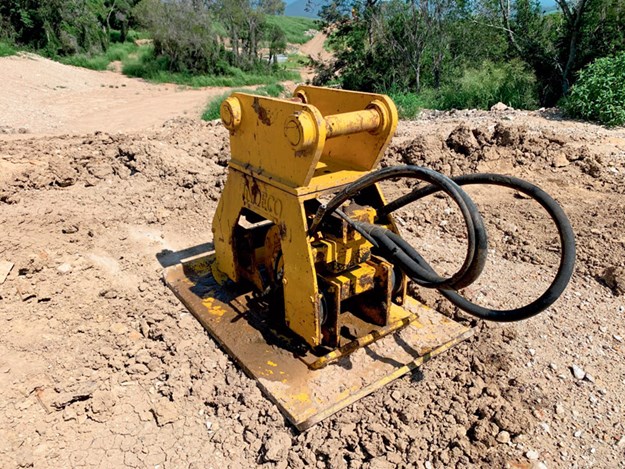 |
|
The Indeco is simplistic in design, cost effective, affordable and requires little maintenance
|
THE TOOLS
In the bush one does not always have the opportunity to access the most suitable equipment necessary to undertake some jobs, but what we lack in choice we make up with innovation.
It just happened that I could source the gear best suited for this particular undertaking, that being a Cat 311 with a slightly longer dipper arm and blade, complete with most of the attachments I required, but I was in dire need of a hydraulic plate compactor for the excavator.
The 11/12 ton Cat excavator just happens to be one of my favourites and plate compactors have been around for over 40 years now but, believe it or not, there is not that many available when you want one.
This machine came supplied with an Indeco hydraulic vibrating plate, a used purchase from Australian Hammer Supplies fitted with a 600 x 800mm wide base plate and also fitted with a rotating head.
This item was pivotal in the successful, speedy and safe execution of the dam wall repairs.
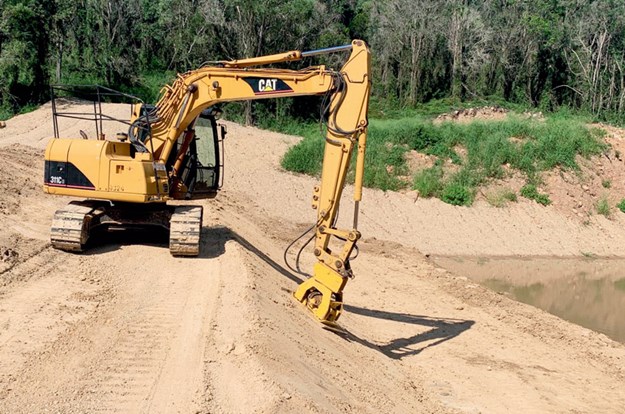 |
|
A safe, neat, speedy and tidy execution of the repairs
|
THE OUTCOME
By working from the inside bottom of the dam wall and keeping the in-flow to a minimum by pumping the water into the new dam we were able to excavate some 10m inside the dam wall by following the hole to a depth of two metres below the existing water level.
Our clay and rock-bunded working base proved to successfully withhold any water from entering our workings and with 57 articulated dump truck loads of clay bought in from the on-site clay pit, we were able to not only build the dam wall but backfill and compact the rather large excavation we had created by opening up and then backfilling/compacting the affected area.
Working two metres below water level, 10 metres inside the dam wall and in an excavation five metres wide, we had to work at full extension of the little Cat to successfully plug the gap. The confined space meant that it was a huge undertaking to create a safe working area for any conventional compacting gear to work in, but with the Indeco vibrating plate attached to the little Cat excavator we were able to execute the repair works within a three-day period.
The material now in use had plenty of moisture in it after the weeks of rainfall and by keying the new false wall into the existing damaged wall we were able to create a new 50m-long wall some three-metre wide from the bottom to the top mark of high-water level.
The successful project would not have been achieved without the small equipment all perfectly suited to such a job. The Indeco vibrating plate played a vital major role alongside the versatility of the bladed Cat 311cu excavator.
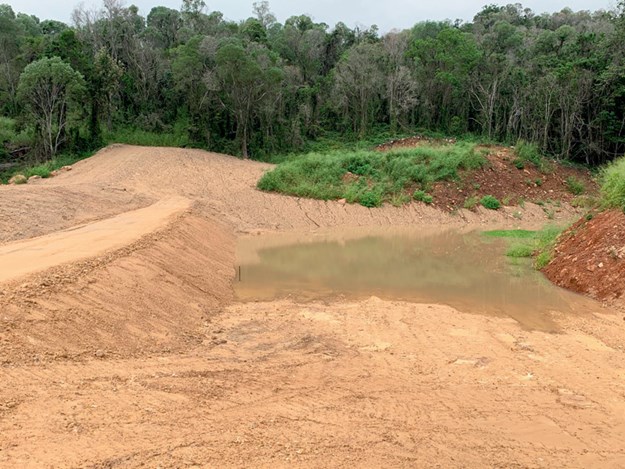 |
|
Job done, with five megalitres of water saved – and the gullies keep running and filling – great outcome
|
THE HISTORY
Indeco/IHC compactors are a very efficient replacement both for traditional risky and tiring manual equipment and for self-propelled rollers, especially if there is a risk of rollover during slope applications or cave-in of trench walls in deep excavations.
Perfect for working on grainy, cohesive and semi-cohesive soils, optional adapters on the vibratory plate turn them into highly-efficient pile-driving tools. Indeco’s rotating compaction plate, the IHC R, makes it much easier to position the excavator at the right angle to the working surface, especially for jobs in narrow pipe trenches and confined areas, where the compaction plate needs to reach into difficult corners or skirt round manholes and other obstacles.
With a great range of compaction plates available, sizes vary to suit the size of the excavator and of course the application for the tool.
This one weighed in at about 650kg, required about 120 litres per minute at 138 bar, achieves a compaction frequency of 2,100 litres per minute and was fitted with a 360-degree rotating head.
With its simplistic operation and simplistic design, along with being inexpensive to purchase and maintain, made this the perfect tool for this particular application. I love it!

